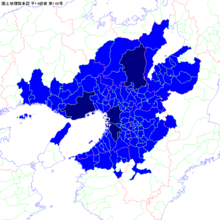List of metropolitan areas in Japan by population


This table contains lists of Japanese metropolitan areas (都市圏), as defined by the Statistics Bureau of Japan (SBJ). The lists include the prefectures containing the region, the population of the region, and the central cities of each region. The region containing most of the people in Japan between Tokyo and Fukuoka is often called the Taiheiyo Belt.
- Usage note: Metropolitan area populations are often controversial and the methods used to calculate them vary from country to country and source to source, so great care should be taken when comparing the figures in this table with figures for any other country. Meaningful comparisons of metropolitan area population figures can only be made if the methods used to determine each figure are consistent.
Definition
The Statistics Bureau of Japan (SBJ) defines a metropolitan area as one or more central cities and its associated outlying municipalities. To qualify as an outlying municipality, the municipality must have at least 1.5% of its resident population aged 15 and above commuting to school or work into one of the central cities. To qualify as a central city, a city must either be a designated city of any population or a non-designated city with a city proper population of at least 500,000. Metropolitan areas of designated cities are defined as "major metropolitan areas" (大都市圏) while those of non-designated cities are simply "metropolitan areas" (都市圏). If multiple central cities are close enough such that their outlying cities overlap, they are combined together and a single metropolitan area is defined rather than independently.
The metropolitan areas written in bold are the 11 major metropolitan areas of Japan.
- 2010
- MMA : Major Metropolitan Area
- MA : Metropolitan Area
- Source: Statistics Bureau of Japan[1]
Changes from 2005 census The following changes to metropolitan area definitions were made in the 2010 Census report.[2]
- New central cities in Kantō and Keihanshin major metropolitan areas
- Sagamihara in the Kantō MMA and Sakai in the Keihanshin MMA have become designated cities in 2010 and 2006 respectively. These cities are already well within their MMAs and should not greatly alter their formation.
- Niigata and Okayama major metropolitan areas
- Niigata became a designated city in 2007 and Okayama became a designated city in 2009. These cities therefore formed major metropolitan areas in the 2010 census.
- Shizuoka, Hamamatsu major metropolitan area
- Utsunomiya metropolitan area
- Utsunomiya qualified as a central city for the 2010 census, resulting from mergers with neighboring municipalities and subsequent population growth.
2005 census
The metropolitan areas written in bold are the 8 major metropolitan areas of Japan.
- Oct. 1st, 2005
- MMA : Major Metropolitan Area
- MA : Metropolitan Area
- Source: Statistics Bureau of Japan[3]
Urban Employment Area
Urban Employment Area is another definition of metropolitan areas, defined by the Center for Spatial Information Service, the University of Tokyo. The Japan's Ministry of Economy, Trade and Industry defined 233 areas for the UEAs of Japan.[4]
See also
References
- ↑ Statistics Bureau of Japan, 2010 Census Final Data
- ↑ Statistics Bureau of Japan
- ↑ Statistics Bureau of Japan, 2005 Census Final Data
- ↑ 経済産業省の地域政策におけるエリア概念について [Area concept in the regional policy of the Ministry of Economy, Trade and Industry] (pdf) (Report) (in Japanese). 2014-10-07. p. 3.